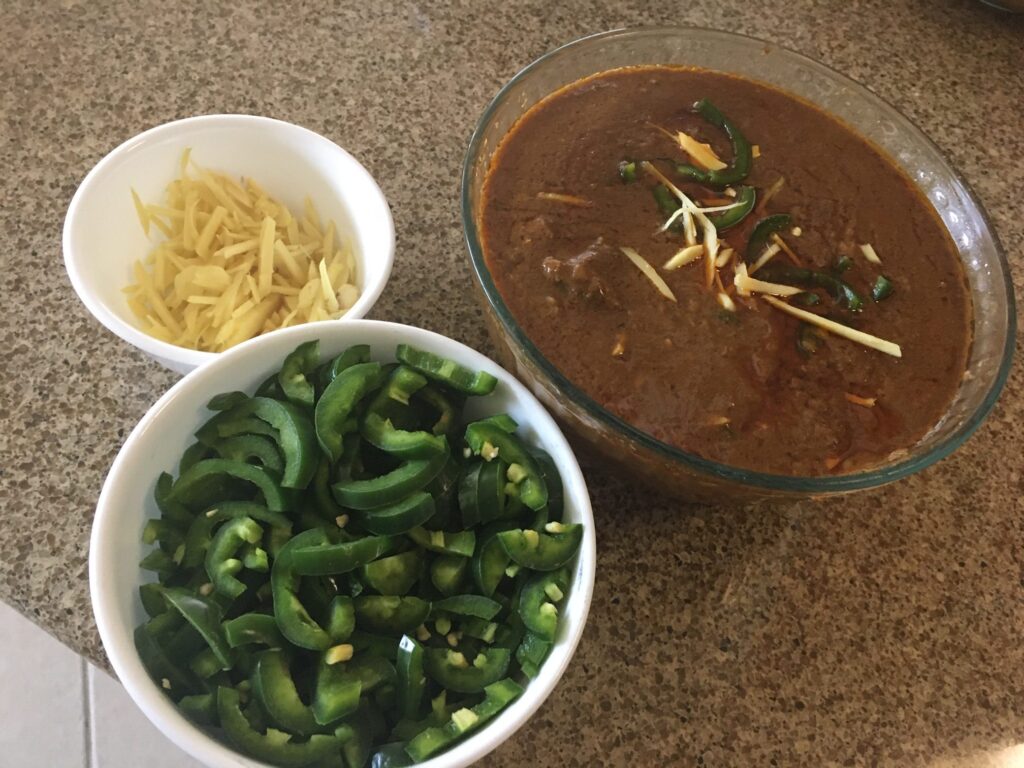Recipes from Home: The Story of Nihari

By Saleena Jafry, Business and Policy Director, Asia Society Texas
What is Nihari?
Nihari is one of the most famous and popular dishes across South Asia, especially in Pakistan. It is a hot, and spicy stew that is hearty, immensely flavorful, and lip-smacking delicious! Given how rich it is, many suggest that it is best eaten in the earliest hours of the day, as it provides energy to the body throughout the day and also allows time to digest the food. As such, it is not consumed as an everyday meal, but is worth every flavor induced calorie. From the kitchens of the Nawabs in Lahore to the trade lanes and ports of Karachi, Nihari is enjoyed by the young and old across Pakistan. The making of Nihari is deliberate, with complex ingredients intentionally layered to develop its deep flavor. This hearty stew is designed to nourish the body and jump-start the taste buds – and, depending on the eaters’ tolerance for spices, wake up one’s sinuses as well – on cold winter mornings.
What is the history of Nihari?
There is some dispute about the origins of Nihari, with various sub-cultures claiming it as their own. Some argue that Nihari originated in Old Delhi during the late 18th century, during the last days of the Mughal empire, while others insist that the dish was inspired in the royal kitchens of Lucknow in modern day India. It is said with a stew this rich and heavy, Emperors were inclined to take long naps after eating a plate of it during the Mughal era. Nihari comes from the Arabic word nahaar meaning day, further supporting the claim that the dish has historically been enjoyed in the mornings. While it may have originated in the royal kitchens, the dish has been adapted by different regions and has served as a canvas for chefs in kitchens everywhere. Much like the hearty stews from European farms, this can be a practical dish designed to nourish the working classes of Karachi without wasting any parts of the precious animals (think Nihari with organ meats and bone marrow – the Nulli Nihari).
How was I introduced to Nihari?
I was first introduced to the majestic Nihari at Sabri Nihari, which is a patio restaurant near Aram Bagh in Karachi, and was one of my father’s favorite restaurants. I was only five years old at that time, but it marked the start of a life-long love for the dish (and perhaps, food in general). Decades later, it is still a delightful treat when Nihari is cooked at home, but given how long it takes to prepare the dish, it’s become part of our celebration meals for special events.
What is the Secret to cooking Nihari?
Nihari involves the slowcooking of the meat with stock and spices in a large vessel. About 50 different varieties of spices can be used, including the garam masala (which itself is a blend of several herbs and spices), cumin, cardamom, cinnamon, cloves, paprika, garlic, and ginger. Though Nihari can be made with beef, mutton, or chicken, it tastes best when cooked with beef shank that is braised in the aromatic and delightfully spicy blend of masalas for at least eight hours, and for up to 48 hours over fire or in the oven (“low and slow” is the key here). Gently, the meat soaks the flavor of the masalas to create a stewy dish. The secret of cooking the best Nihari lies in experience and proportion management and, as such, the best taste lies in the hands of the chef.
What is the best way to enjoy Nihari?
Nihari should be served piping hot, and garnished with cilantro, ginger, jalapenos and lime or lemon. It is best eaten by hand, with the gravy mopped up into small pieces of naan (flatbread) serving as the delivery utensil.
Where can one find Nihari in Houston?
There are many restaurants in Houston serving Nihari, but one of the best Niharis can be found at DDK or at Ashar’s Kitchen, both of which are located on Hwy 6 in Sugar Land.